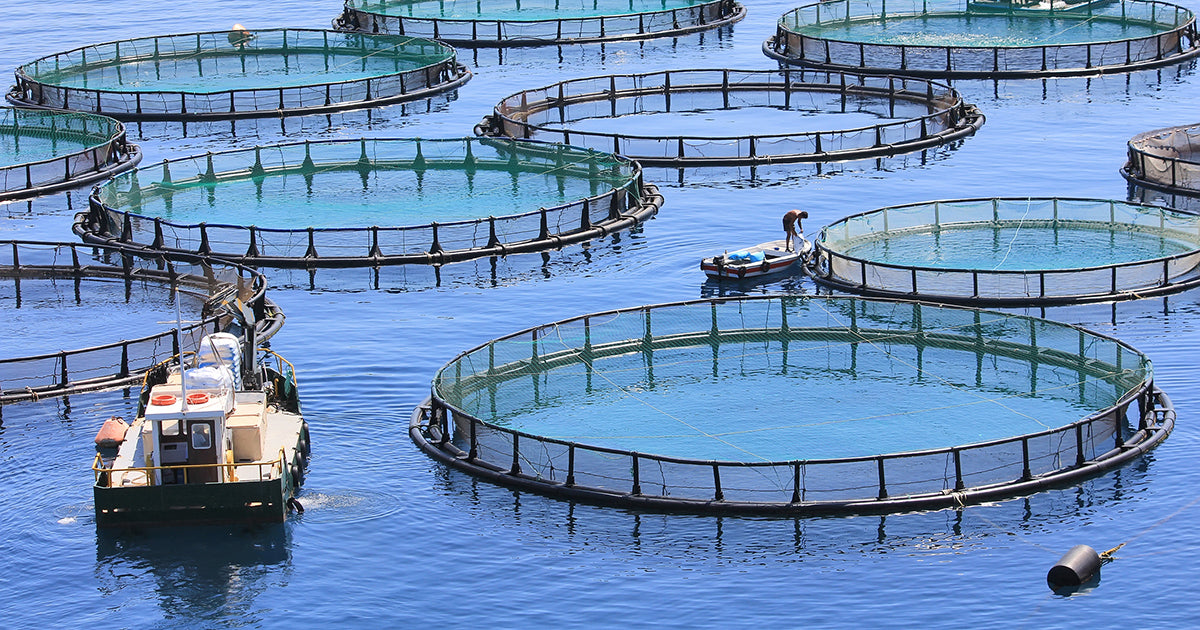Farm-Raised Fish Myths Debunked

In recent years, farm-raised fish have faced scrutiny and skepticism fueled by myths about their nutritional quality and environmental impact. However, as global consumption shifts toward aquaculture—with over 50% of global seafood now coming from farme sources—it is crucial to re-examine these assumptions using robust, data-driven insights.
A new data-driven analysis by Fulton Fish Market compares farm-raised and wild-caught fish to evaluate their nutritional profiles and environmental sustainability, debunking common misconceptions.
Key Takeaways
- Over 50% of global seafood now comes from farm-raised sources, highlighting the sector's massive expansion.
- The controlled diets in aquaculture have boosted omega-3 fatty acids in farm-raised fish by approximately 4% compared to their wild-caught counterparts.
-
Integrated multi-trophic aquaculture systems—including co-culture with seaweed—could sequester up to 1.5 billion tonnes of CO₂ per year.
Nutritional Profile
Critics have long claimed that farm-raised fish are nutritionally inferior to their wild-caught counterparts. Data, however, paints a more nuanced picture.
Fat and Omega-3 Content
Farm-raised salmon typically contains between 14-16 grams of fat per 4oz serving, compared to 7-8 grams in wild-caught salmon. Despite the higher fat content, controlled diets in aquaculture are designed to boost omega-3 fatty acids. For example, studies indicate that farm-raised salmon can contain about 4% more omega-3s due to such fortified diets, ensuring levels that meet or even exceed dietary recommendations.
| Nutrient | Farm-Raised Salmon | Wild-Caught Salmon |
|---|---|---|
| Protein (g) | 22 | 22 |
| Fat (g) | 15 | 7.5 |
| Omega-3 (g) | 2.1 | 2 |
| Vitamin D (IU) | 526 | 988 |
| Calories | 225 | 165 |
| Calcium (mg) | 12 | 12 |
| Iron (mg) | 0.5 | 0.9 |
Protein and Micronutrients
Both sources provide high-quality protein with comparable levels between farm-raised and wild-caught fish. While minor variations in micronutrients exist—farm-raised fish may sometimes show differences due to feed composition—the essential nutrients remain well-preserved across both types.
“While it is true that farm-raised salmon has a higher fat content, this is a direct result of intentional, controlled feeding practices designed to optimize growth and nutrient density,” explained Robert DiGregorio, Director of Quality at Fulton Fish Market. “Far from being a drawback, this results in a consistent, reliable source of high-quality protein and essential micronutrients vital for human health.”
Environmental Sustainability
The environmental impact of aquaculture is debated, but several key data points highlight significant improvements and real benefits in the modern context.
“Modern aquaculture is transforming seafood production by reducing pressure on wild stocks. With innovations—from improved waste management to integrated multi-trophic systems—farm-raised fish now play an instrumental role in reducing environmental impacts while meeting global seafood demands,” underlined DiGregorio.
Advancements in Sustainable Practices
Recent innovations in aquaculture are delivering tangible environmental benefits. For instance, seaweed aquaculture—a complementary practice within fish farming—has the capacity to sequester up to 1.5 billion tonnes of CO₂ annually. This not only offsets some of the carbon emissions associated with traditional aquaculture but also contributes to broader environmental remediation efforts.
Pollution and Ecosystem Management
While past aquaculture practices were associated with pollution, habitat degradation, and disease transmission, modern fish farms have made significant strides in mitigating these effects through advanced waste management systems, sustainable feeding practices, and continuous monitoring of water quality. Additionally, the shift towards recirculating aquaculture systems (RAS) helps contain waste and minimize environmental footprints.
Production Volumes and Stability
Aquaculture now accounts for production volumes surpassing wild catches globally. This growth, observed as recently as 2024, indicates that the industry is scaling sustainably under improved regulatory and innovative practices, ensuring consistent production without compromising environmental integrity.

Debunking the Myths
Myth 1: Farm-raised fish are less healthy
Despite higher fat and caloric content, the nutrient profile of farm-raised fish—especially their omega-3 levels, which can be as much as 4% higher—ensures they are a healthy dietary choice.
Myth 2: Aquaculture is inherently unsustainable
While environmental challenges exist, ongoing technological advances and improved management practices have mitigated many of these issues, demonstrating that sustainable aquaculture is not only possible but is already contributing over 50% of the global seafood supply.
Myth 3: Wild-caught fish are always nutritionally superior
Although wild-caught fish typically have lower fat content, they do not consistently deliver higher levels of essential nutrients compared to their farm-raised counterparts, particularly regarding omega-3 fatty acids crucial for heart and brain health.
However, this comparison overlooks the larger issue: nearly all seafood is remarkably nutritious, and people are not consuming enough of it. Experts recommend eating seafood at least twice per week in order to reap the broad range of health benefits these foods offer.
Complexities of Modern Seafood Production
The comparison between farm-raised and wild-caught fish reveals that a binary judgment does not capture the complexities of modern seafood production. For DiGregorio, “evaluating seafood solely based on wild versus farm-raised oversimplifies the complex environmental and nutritional dynamics at play.” Data-driven insights show that sustainable aquaculture practices not only protect marine ecosystems but also contribute significantly to global food security.
Consumers should evaluate both nutritional trade-offs and sustainable practices when making decisions. Advances in farmed fish production, such as improving feed quality and reducing ecological impacts, show that farm-raised fish offer a viable, nutritionally robust alternative alongside wild fisheries.
Data-driven insights dispel persistent myths about farm-raised fish. By highlighting concrete data points—such as the 4% higher omega-3 content, the specific fat and calorie comparisons, and the impressive contribution of aquaculture to global seafood supply— ”it's clear that modern aquaculture is a sustainable and high-quality source of seafood, analyzed DiGregorio”.
Methodology
The study employed a comprehensive, data-driven approach by integrating secondary data from academic publications, industry reports, and government sources. Data cleaning, standardization, and integration techniques were applied to merge nutritional metrics and environmental indicators, allowing for robust comparative analysis. Descriptive and trend analyses were conducted on key parameters such as fat content, omega-3 levels, caloric values, production volumes, and sustainability metrics, including reductions in wild fish pressure and potential CO₂ sequestration from seaweed farming. The quantitative findings were further complemented by qualitative evaluations from consumer surveys and expert opinions, enabling an informed synthesis that debunks prevailing myths about farm-raised fish.
Additional Resources
- FAO. (2022). The State of World Fisheries and Aquaculture 2022: Towards Blue Transformation
- NOAA Fisheries. (2023). Fisheries of the United States Report
Global Aquaculture Alliance. (2023). Best Aquaculture Practices (BAP) Standards - Advice about Eating Fish
